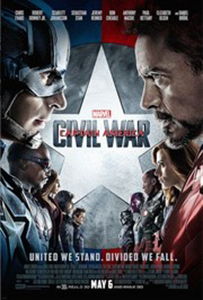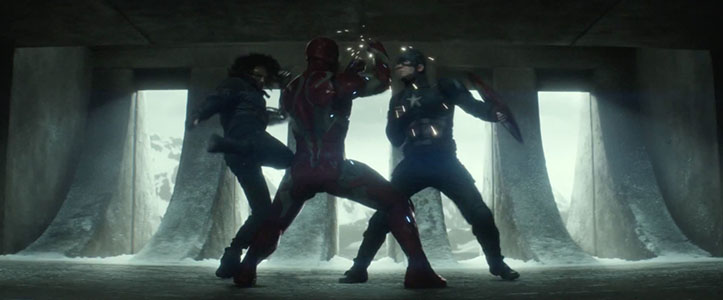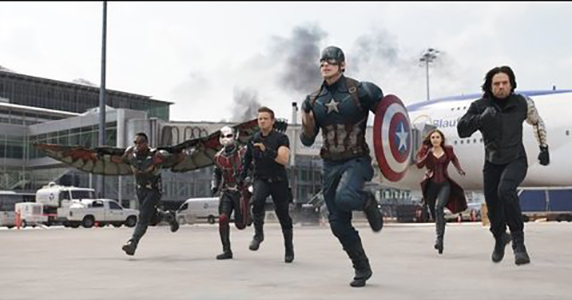“Captain America: Civil War” (i.e. Avengers 3) addresses a major issue in the Marvel Cinematic Universe—namely, there are too many damn characters in these films! The casual fan will struggle to remember who everyone is, why they are there, or really why they should care. At some point, the Avengers had to be broken down into smaller, more palatable groupings to keep the majority of the audience engaged. Still, “Civil War” does a surprisingly decent job of focusing the story on Captain America and Iron Man despite having a dozen other superheroes in the mix. What could have been a complete mess turns out to be one of the better Marvel movies.
Marvel’s “Captain America: Civil War” finds Steve Rogers leading the newly formed team of Avengers in their continued efforts to safeguard humanity. But after another incident involving the Avengers results in collateral damage, political pressure mounts to install a system of accountability, headed by a governing body to oversee and direct the team. The new status quo fractures the Avengers, resulting in two camps-one led by Steve Rogers and his desire for the Avengers to remain free to defend humanity without government interference, and the other following Tony Stark’s surprising decision to support government oversight and accountability. (Synopsis by Walt Disney Pictures)
A few weeks back we were subjected to “Batman v Superman,” a film only slightly more awful than the decision to use “v” in the title. “Civil War” shares some of that film’s plot points, primarily the problems with wanton destruction of innocents in the pursuit of a kick-ass fight scene. Add in some elements of the classic X-Men storylines involving the registration of superheroes, and you’ve basically got the plot of this film. “Civil War” finally gets the tone right on both of these plot devices. While Batman got too moody and X-Men relied on external forces to create and resolve the conflict, this film keeps the plot entrenched in the fundamental disagreement between Iron Man and Cap about personal freedom. Neither position is entirely right nor wrong, adding a crucial nuance to a genre that tends to focus on the good versus bad motif.
The writers not only got the theme right here, they managed to keep this a fun and engaging movie over its extended runtime. The careful use of humor throughout the darker parts of the plot and the fight scenes keeps this film from tottering to close to the brooding nature of its rivals. Particularly enjoyable is the inclusion of a younger and goofier Spider-Man—the more childish take on Peter Parker works exceptionally well. The presence of a fresh-faced Peter Parker still in awe of other superheroes only works when that character isn’t the focus of the film, but it is nice to see a script stick closer to the source-material age of a character instead of adding years for the benefit of the movie screen (that’s you, “Ender’s Game”). We’ll see how this incarnation of Spider-Man holds up when he helms his own film next year.
Not to say that there aren’t weak spots in “Civil War.” The conflict at the heart of the plot doesn’t always ring as true as it could. In the comic, Iron Man embraced the registration idea as an immediate response to the loss of innocent lives. The cinematic version has to have that loss thrown in his face before choosing to back the registration act to the other Avengers. More time should have been spent fleshing out Tony Stark reaching that decision on his own, and grappling with the consequences of his actions. There is plenty of source material to pull from to make the Cap/Iron Man conflict an outgrowth of the heroes themselves, instead of diluting the argument by putting it in other characters’ mouths.
Then you have the aforementioned problem of the sheer volume of Marvel characters the audience has to keep straight. Sorry Don Cheadle, but we’re all going to spend 45 minutes trying to remember what you’re doing here (and that you’re the supposed to be the same person as Terrance Howard, even). Worse, it’s eventually revealed that an evil mastermind orchestrated everything, because apparently you have to have that in a superhero film. But given the weight of the central conflict between the two camps of superheroes, the villain’s presence becomes an unneeded distraction. That whole piece could be removed without affecting the resolution of the main plot. Ultimately, these compilation films have to subtract characters to have a cohesive narrative—jumping between plot points for 20 characters does not make for a watchable movie.
This is the problem for Marvel going forward. The long-term plan is to continue to add individual character franchises (“Doctor Strange,” “Spider-Man: Homecoming” and “Black Panther” are next) while trying to occasionally compress all of them into compilation films. It’s becoming more difficult and unlikely that the latter can continue to be successful. In 2015, Steven Spielberg said that “we were around when the Western died, and there will be a time when the Superhero movie goes the way of the Western.” How close are we to that reality? How many characters can Marvel introduce before the audience’s tolerance is expended? Films like “Civil War” are a positive step, but only time will tell.
“See It/ Rent It/ Skip It”: See it. Even Ant-Man is enjoyable in this. Seriously—Ant-Man!
THREE STARS out of four.
Directed by: Anthony Russo and Joe Russo
Rated PG-13 for extended sequences of violence, action and mayhem.
Runtime: 2 hr, 26 min.






Leave a Reply
You must be logged in to post a comment.